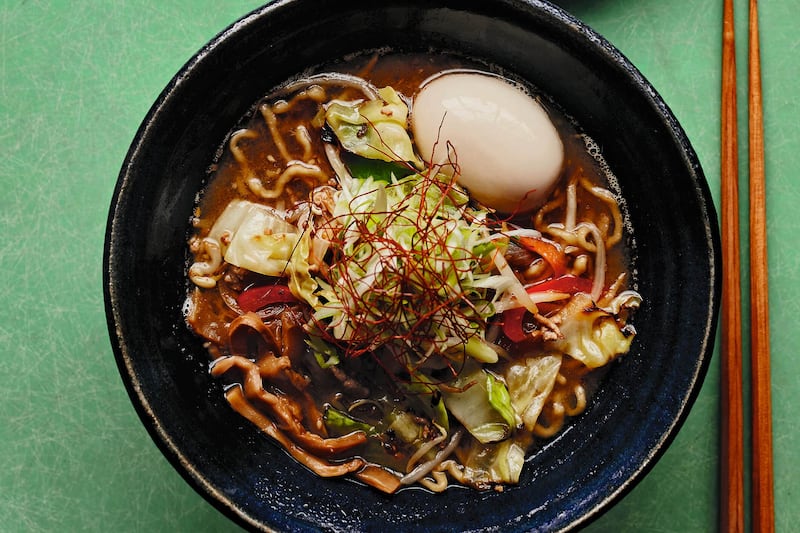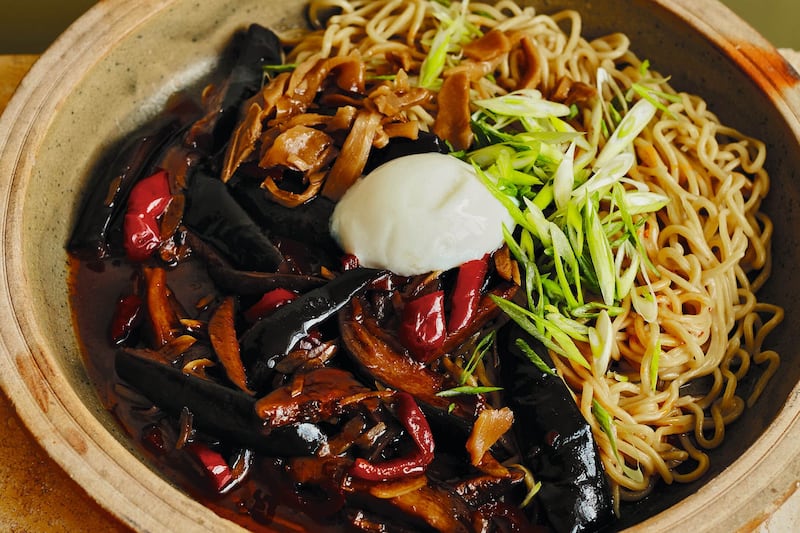THE thing about Tokyo, explains chef Tim Anderson, is that it's so vertical. "It's not just that it's busy on one level, it's busy in three dimensions – it's a bonkers city."
And that applies to the food as much as the architecture, hence why it's the subject of the London-based, Wisconsin-born restaurateur's latest cookbook, Tokyo Stories.
There are physical and geographical layers to Tokyo's food, starting with the eclectic, hi-tech vending machines on the subway; the conbini convenience stores where you can order yakisoba pan (fried noodles in a bun) or rice balls; then the street food, like yakitori (Japanese chicken skewers), tempura and ramen.
Plus there's Japanese home cooking ("Kitchens in Tokyo are very small. You might just have a microwave and a two-ring electric burner," says Anderson), followed by really fine Japanese dining, high-end stuff like kaiseki (multi-course dinners) and sushi, as well as regional foods you can't get unless you go to that region (except you can get it in Tokyo).
"I wanted to get the whole range," says Anderson, who won MasterChef 2011, and who first visited Japan in 2002 after his parents bought him a package tour as a high school graduation present. "I was barely 18, and I remember Tokyo being so crowded and bright and crazy and just with so much going on that I was actually really intimidated by it."
His defining edible memory of the trip is the bewilderment involved in ordering a burger from fast food chain, First Kitchen. "It was just really hard," he says wryly. "Ordering fast food is not as straightforward as you think, there's always options."
Going on to teach English in Japan for two years, he later discovered that the joint's fries – dubbed 'Flavour Potato' – come with amazing little seasoning packets you shake up with your chips, so they taste like soy sauce and butter, or garlic and miso. Anderson's done his own shake-and-season version in the book.
Now 34, he's got something of a handle – as much as it's possible – on Tokyo's madcap culinary landscape, and uses his visits to explore "unusual parts of Tokyo to find different kinds of food".
As such, he's too busy seeking out new things to have a roster of favourite restaurants to revisit. "I mainly only know what ramen shops to go to," says Anderson with a laugh. "And karaoke bars."
While shooting the book, his photographer dragged him to temples and gardens – "and I hardly even knew those were in Tokyo!"
That trip also saw Anderson, who runs Japanese soul food restaurant Nanban in south London, trying to track down specialities particular to the city – which was tough, because it turns out capitals don't much have them.
"That's partly because food is connected to agriculture, and there's not really any agriculture in the city." But outside of Tokyo's most "bonkers" districts, like Kabukicho, Shinjuku and Shibuya, he did unearth dishes specific to the fishing communities of Tokyo Bay, and also found that, actually, "it's not crazy in some parts of town. Some parts of Tokyo are really serene and you can breathe, and there are parks, and schoolchildren and sky and old ladies."
His main aim with Tokyo Stories is to convey the diversity of the food available. "You can go to Tokyo, but also go to France," he explains. "There's fantastic French food and Parisian bakeries."
In fact, "there's a lot of everything," he says. Take the city's clashing pizza culture. "There are two schools of pizza in Tokyo," explains Anderson. "The really nice stuff, and then you get the Japanese equivalent of Domino's, and those are good in a different way, because they're so crazy. They'll usually have Japanese-style toppings on them, or there's a trend now for doing Korean barbecue meat on pizza."
Most intriguing of all perhaps are Japan's convenience stores, which Anderson says are "very special". "Sometimes I think they're my favourite thing about Japan generally," he adds.
He says it's down to the fact they are incredibly well run, thanks to a logistics system that means each branch receives multiple deliveries a day, so fresh produce is never sitting on the shelf for long.
"And then they're cooking in there too," Anderson buzzes, awed. "You can get fried chicken in the convenience store by the way! They take it out of hot cupboards, but they're cooking throughout the day. They've got little fryers out the back, so when they need to top up the fried chicken, they just make it."
Then there's steamed buns and vats of dashi bobbing with vegetables ("They give you a big bucket with a handle, top up the broth and it's the best thing to eat in the winter"), and bottled ice teas in every flavour.
"They're magical places," Anderson declares. "I didn't pack enough underwear, so I went to the convenience store – got underwear! They have everything you need, they're fantastic."
He makes it sound like you'd struggle to find fault with any of the city's food, whether you nabbed it from a machine between subway stops, or found an Okinawan-inspired hole-in-the-wall. "I've been to my fair share of bad ramen shops, it's not like it's a paradise of perfect food everywhere," he concedes, "but it's pretty close."
:: Tokyo Stories: A Japanese Cookbook by Tim Anderson, photography by Nassima Rothacker, is published by Hardie Grant, priced £26. Below are two recipes from the book for you to try.
OMURICE
(AKA seasoned rice topped with an omelette – and ketchup!)
(Makes 1 big omurice enough for 1 hungry person, or 2 not-that-hungry persons)
30g butter
1 banana shallot or small onion, diced
60g shiitake mushrooms, destemmed and diced
1 chicken thigh, boneless and skinless, cut into 1cm cubes (optional)
300g cooked rice (from 150g uncooked; rice that has been chilled in the fridge works best)
Ketchup, to taste, plus extra to serve
Soy sauce, to taste
Salt and pepper, to taste
3 eggs, beaten with 1 tbsp double cream (optional)
Method:
Melt half of the butter in a frying pan over a medium heat, then saute the shallot or onion until translucent. Add the shiitake and the chicken (if using) and saute until the mushrooms soften and the chicken is cooked through.
Add the rice, breaking up any clumps, and stir in the ketchup, soy sauce, salt and pepper. Meanwhile, melt the remaining butter in a non-stick frying pan over a medium-high heat, then tip in the beaten eggs and season with a little salt.
Cook the egg until set on the bottom but still runny on top, then gently fold the eggs over themselves so the runny bit is now in the middle. Scoop the fried rice into a mound on a plate, then tip the omelette onto the top of the rice. Serve with more ketchup, if you like.
MAPO RAMEN - SICHUAN SPICED TOFU NOODLES
(Serves 4)
600g-700g firm or extra firm silken tofu
Water
Big pinch of salt
2tbsp Sichuan pepper
4 dried red Chinese chillies
4tbsp vegetable oil
2 anchovy fillets (optional)
1 bird's eye chilli (or more, to taste), finely sliced
4 garlic cloves, finely sliced
15g piece of ginger root, peeled and finely shredded
300g minced pork
1tbsp preserved black beans
80g doubanjiang (black bean sauce)
1 1/2 tbsp caster sugar
500ml chicken stock
1tbsp sesame oil
1 1/2tbsp cornflour, mixed to a paste with a little water
Worcestershire sauce and/or soy sauce, to taste
4 portions thick ramen noodles
For the garnish:
Small handful of coriander, roughly torn
Sesame seeds, toasted until deep golden brown
Plenty of sansho pepper
Method:
Cut the tofu into 2.5-cm (1-in) cubes and bring a pan of water to a low simmer along with the salt. Carefully add the tofu to the salted water and poach for 10 minutes. Remove gently with a slotted spoon. Toast the Sichuan pepper and dried chillies in a dry frying pan until aromatic and beginning to colour, then leave to cool and grind to a coarse powder.
Add the oil to the pan and place over a high heat, then add the anchovies, if using, and the bird's eye chilli. Fry for a minute or two, then add the garlic, ginger and pork and fry until the pork is browned. Add the black beans, doubanjiang, sugar and the ground Sichuan pepper and chillies. Cook for a few minutes, stirring often, so the flavours meld.
Add the chicken stock and sesame oil and bring to the boil, then stir in some (not all) of the cornflour-water mixture. Let the sauce boil for a few minutes to thicken, stirring continuously; add more cornflour slurry if you want it thicker (it should be quite thick so it clings well to the noodles). Taste the sauce and adjust seasoning with Worcestershire and/or soy sauces. Gently stir in the tofu, using a pushing motion with the back of your spatula and shaking the pan to coat the tofu without breaking it up.
Bring a large pot of water to a rolling boil and cook the noodles until al dente. Drain well, then transfer to four bowls. Top with the hot tofu mixture and garnish with the coriander, sesame seeds and sansho.








